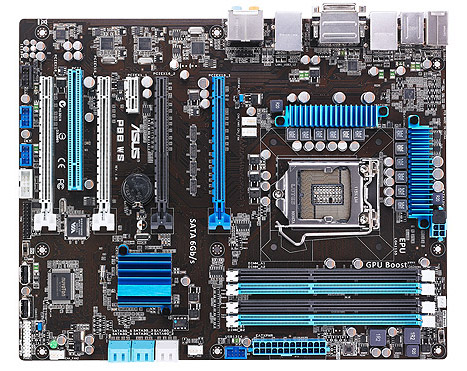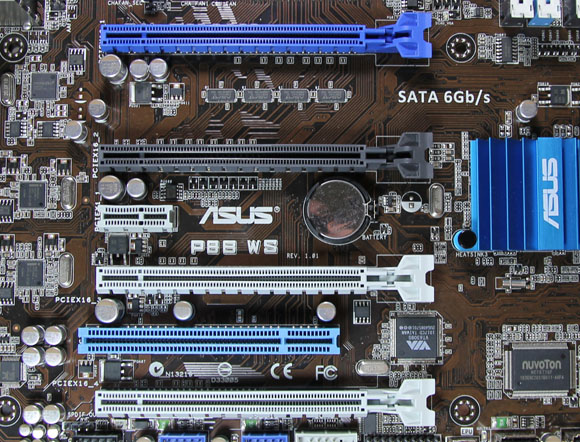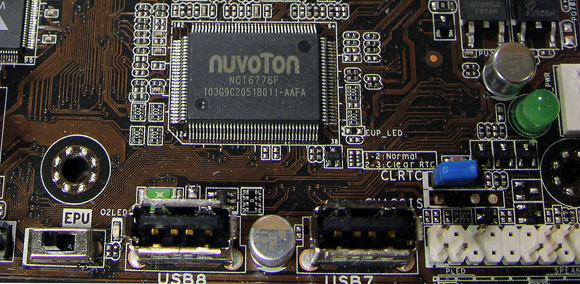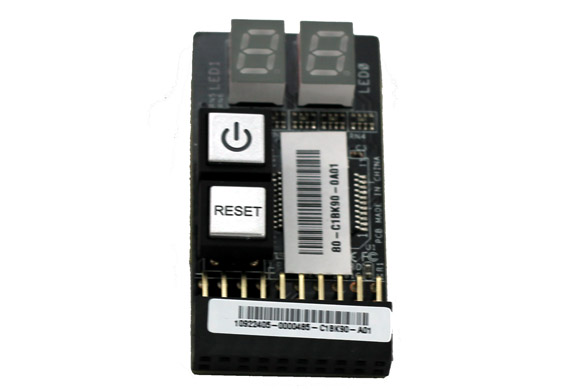Today we are looking at the ASUS P8B WS motherboard for Intel’s E3-1200 series Xeon CPUs. Based on the C206 chipset, the P8B WS is able to utilize the Xeon CPUs with a five as the last number (e.g. Xeon E3-1235) and take advantage of Intel’s onboard GPU. By enabling the Sandy Bridge graphics engine, the ASUS P8B WS makes a strong play for single processor workstation applications. As with the C206’s sister chipset on the consumer side, the H67, the C206 does not have overclocking potential like a P67 or Z68 motherboard. On the other hand, most workstation users prioritize stability over overclocking so the inability to overclock the CPU a great deal is more than compensated for by the ability to utilize ECC DRAM for greater stability.
Test Configuration
For this test configuration I had to use a Xeon E3-12×5 CPU to enable the onboard video and decided to use the E3-1235. The reason for this was simply that I believe the E3-1230 and E3-1235 are currently the best value ECC enabled CPUs on the market.
- CPU: Intel Xeon E3-1235
- Motherboard: ASUS P8B WS
- Memory: 8GB ECC 1333MHz CL9 DDR3 (4x2GB)
- OS Drive: OCZ Agility 2 120GB
- Additional NICs: Intel Gigabit CT PCIe x1 network adapter, Intel Pro/1000 GT PCI network adapter
- Enclosure: Norco RPC-4224
- Power Supply: Seasonic X650 (650w Gold level power supply)
A quick recap of the Bromolow platforms shows that the C206 chipset, unlike the C202 and C204 chipsets does support the onboard video of the Xeon E3-12×5 series chips (e.g. the Intel Xeon E3-1235) so one is likely to want an Intel Xeon CPU with HD graphics over other competitors.

Features
The ASUS P8B WS is a standard ATX size motherboard that has a lot of very desirable features into a relatively small form factor.

Probably one of the first things that one notices looking at the board is that there are a ton of PCIe expansion slots, especially for a Sandy Bridge motherboard, somewhat similar to the P8P67 WS Revolution. The P8B WS has four PCIe X16 physical slots one PCIe x1 and one legacy PCI slot. In contrast the P8P67 WS Revolution has the same four PCIe x16 physical slots with three PCIe x1 slots. One of the biggest differences between the two boards is how the slots are wired. The P8P67 WS Revolution uses the NVIDIA NF200 as a PCIe switch while the P8B WS has two x16 physical slots running in x4 electrical mode and two slots that either run in x16 and not populated or x8 and x8 electrical configurations. There are certainly use cases for both, but as we all know, the NF200 chip found on the P8P67 WS Revolution does not allow for ESXi pass-through so for some users, the P8B WS is going to be significantly more attractive.

In a configuration similar to the ASUS consumer line, the P8B WS has six SATA ports in the lower right portion of the board. These ports all run parallel to the PCB which makes cable management easier, especially with front-of-chassis drive bays. The light blue ports are SATA II 3.0gbps and the white ports are SATA III 6.0gbps. The two SATA III and four SATA II port configuration is common for the C204, C206 server/ workstation and P67, H67, and Q67 consumer/ business chipsets. For those wondering from the picture below, the 4-pin fan header next to the SATA ports is very easy to access even with six SATA cables attached.

One feature I always call out can be found between the ASUS EPU switch and the front pannel connectors. Those are two internal USB headers. the internal headers allow one to insert USB flash drives, for example, into ports located inside the chassis. For operating systems like unRaid and some professional programs, one needs a USB drive or accessory tied to a license installed at all times. Having that important USB drive installed inside the chassis is important if one is trying to keep it safe.

The rear I/O panel of the ASUS P8B WS offers a lot of connectivity. One has a combo PS/2 keyboard/ mouse port, eight USB ports (two of which are USB 3.0) and an IEEE 1394a firewire port (connected to ta VIA 6308S controller that also provides connectivity to the internal header.) The DVI out is a solid way to leverage the C206’s Intel HD video because it can be converted to other formats like HDMI. Audio is handled by the Realtek ALC 892 8-Channel HD CODEC and one can see the six 3.5″ mini jacks and coaxial/ optical S/PDIF outputs on the rear I/O panel. The two LAN ports are supported by Intel 82574L controllers, which are perhaps one of, if not the most used onboard server NICs around. As such the Intel NICs work with Windows, Linux, FreeBSD, Solaris, and VMware ESX(i) so that is a major positive for this type of board.

Features
Probably the coolest feature of the P8B WS (aside from the ones previously mentioned) is the inclusion of a diagnostic board that can be used to show error codes and also provide power and reset switches during setup and troubleshooting.

I have used the diagnostic board on a few ASUS motherboards, especially in conjunction with the ASUS MemOK! feature to troubleshoot memory problems at boot-up. Since diagnostic LEDs emit light, I tend to like the ability to remove them from the motherboard once I am done using them to cut down on light emanating from the system.
Software
Probably the most interesting piece of software is the UEFI interface that ASUS provides. For those accustomed to standard BIOS that have been used for decades, the ability to use a mouse is welcome. I did find though that using a mouse was almost necessary as navigating by keyboard was not as slick as old AMI, Phoenix, and Award BIOS implementations. The UEFI interface provides a simple mode (called EZ mode) that shows things like boot order, and lets a user change profiles between a power saving profile, balanced profile, and performance profile.
Beyond the UEFI interface, ASUS provides a suite of software including AISuite II, AICharger+, and ASUS Fan Xpert. Plenty of details can be found on ASUS’s site, but the highlights from this software are the abilities to:
- Monitor system information from fan speeds, temperatures, voltages, clock speeds and etc. and set alerts.
- Overclock the CPU if desired either manually or using a CPU auto tuning feature. The base clock can be increased too by a small amount as 100MHz to 103MHz base clocks are generally obtainable from a 100MHz base. One cannot change the multiplier with K series CPUs on the C206 chipset much like the Intel H67 chipset.
- Set the EPU power saving profiles and features. The EPU is a feature of ASUS motherboards meant to intelligently reduce power consumption.
- Set and test fan speeds using Fan Xpert. This can be useful if one wants to set thresholds and test them for quieter idle fan speeds ramping up as the workload increases.
- Enable fast charging (up to 3x faster claimed) using AICharger+
Overall I found these utilities to be fairly useful and given Sandy Bridge’s performance, and the fairly low CPU requirements of the utilities, they are worth installing. One should note that best practice will be to install each utility and driver individually as ASUS does include a small amount of bloatware with their automated installation.
Conclusion
The ASUS P8B WS is a solid board for the single processor workstation market. The new Sandy Bridge CPUs provide ample speed at low power. Unlike many server boards based on the C202 and C204 chipsets with on-motherboard graphics, the P8B WS, by leveraging the C206 chipset and Xeon HD graphics can provide an acceptable graphics solution for those that do not need gaming quality graphics. The ability to put multiple PCIe x16 cards into the motherboard will be very attractive to many users if they need fast storage I/O, Tesla cards or the like. Using things like all solid capacitors shows that ASUS was aiming for long-term stability and reliability with the P8B WS, a goal further bolstered by the ability to use unbuffered ECC DIMMs with the motherboard. Overall the P8B WS is worth a look if you are in the market as it combines some of the best features from the consumer space with single processor workstation must-haves.




Thank you for your review.
I wonder if there’s been any sign of actual usage of the ECC memory functions your memory comes with in conjunction with C206 chipset & XEON cpu.
So far, I have yet to see such a sign on my configuration, which is a XEON E3-1275 plus 4x4GB ECC ram @1333MHz from Crucial. The only thing I can notice is that with some cpu info tools I can see that the memory is 72 bits wide, which is correct, but not whether it’s in ECC mode or not. Also, I cannot find any bios options regarding ECC.
Best regards,
Don
No mention of the VT-d problems with this board? Everyone has been saying that VT-d is not working, and according to an ASUS response on Newegg, “This motherboard and BIOS does support VT-d, however, VT-d is not supported on this board with E3-series CPUs.” This is unacceptable for a workstation board–is it fixed in a later BIOS, or maybe you could get a better explanation from ASUS?
Also, I’d love to see some power consumption numbers.
How about some transcoding testings with the P3000 graphics on the E3-Xeon ?
Don: Great question. Some motherboards actually capture single-bit errors corrected/ double bit detected. I have not seen this on the P8B WS yet. Still, that is a feature that is more interesting for those that just like to look at data rather than useful for an administrative purpose unless there was a very high count indicating a problem.
Brendan: This was semi-intentional. The NewEgg ASUS response (to another one of the three reviews) says that VT-d is supported by the motherboard and chipset, and will be implemented in a BIOS release in a few weeks. I figured I would look at that feature when it comes out and did not want search engines caching that VT-d does not work for the next six months.
NME: I tend to do CPU reviews separately. Like Tom’s I was having an issue getting the Xeon E3’s to work with some of the Quic Sync encoders. Quick Sync is great but software support is not there yet.
I got this board for a server I am building it is just awesome
Well done Patrick. Great reviews. Highly useful to your audience.
Here is a common conundrum. Those building workstations (or in my case, a database server for home development work) find Sandy Bridge price/performance compelling. So we buy a P67/Z68 motherboard, but the on board SATA raid is insufficient, so we buy a SAS/SATA raid adapter card.
Sadly, the feedback on NewEgg warns the PCIe 16x slots on P67/Z68 motherboards do not play nice with raid adapters. Does the C206 chipset improve PCIe bus design and thereby resolve compatibility issues?
I can verify what Chris is talking about. I have the P8B WS, and am having a hell of a time getting it to work with an LSI 9240-4i. The RAID adapter is an x4 device, yet won’t work in either of the (supposedly) x4 compatible slots. I’ve updated F/W on both the MoBo and the card, verified I have the latest version of all drivers, and it still doesn’t work.
Chris: Generally speaking RAID controller compatibility is something that is fairly controller/ motherboard specific. Even things like the HP SAS Expander that pulls power and not data from the PCIe bus can be tripped up by an unsupported SMBus circuit. I have had much better luck with real server products versus workstation/ consumer motherboards and RAID controllers.
BTW Josh, did you happen to try the card in a different slot or is it just that slot where you are having an issue? Thanks for posting since that helps others in the future.
FYI, the latest BIOS from ASUS states VT-d support.
What is the reason for only 1 DVI output?
Anyone got this board working with a 3ware 9650 RAID controller?
FYI – Asus P8B WS with latest BIOS 2009 doesn’s work with LSI RAID controller.
Have YOU tested this board? You might have noticed that “the coolest feature” test board shows all kind of un-documented codes …. or that there is no RAID driver allowing one to install Windows OS. BD82C206 drivers are NOT delivered on CD and no other driver is compatible.
Has anyone installed a 64 bit OS on RAID 1 or RAID 0 on this board ?
Almost 9 years on from this review, I still have an ASUS P8B WS that runs perfectly to this day, and is used everyday as a primary workstation. Equipped with an E3-1235 cpu, 24GB ECC DDR3-1333 Kingston RAM (4GB + 8GB stick in each channel) 3 SSDs, an HDD, an ASUS PCE-AC56 PCI-e wifi card, an ASUS STRIX Radeon RX480 8GB GPU, Corsair AX650 PSU, and 3 monitors, it can still handle running a couple Hyper-V vm’s in the background, while maintaining 60fps in Forza Mortorsport 7 at 5760×1200 Eyefinity resolution. Bios support through June 2019 too, thanks ASUS.
We have two workstations using the ASUS P8B WS. They’ve been running pretty well considering that we got them in 2012. They don’t officially support Windows 10 although we’ve been running this for several year now. The USB 3.0 interfaces on one of of the systems seems to have gone out and I’m thinking that it’s about time to replace these. Guess I’ll go back to SilentPC.com and see what the current offerings will cost. I wonder if it would be worthwhile to try and transfer the Xeon E31275s and Kingston ECC PC3 10600 memory (16GB in one, 32G in the other) to a new MB? Probably not–I suspect I’d eventually regret trying to cut corners like this.